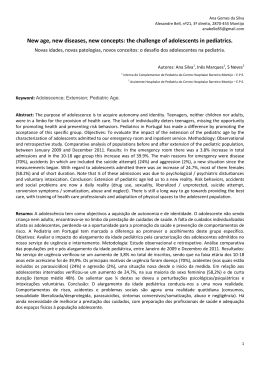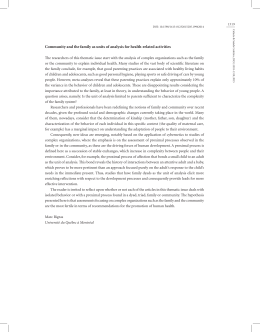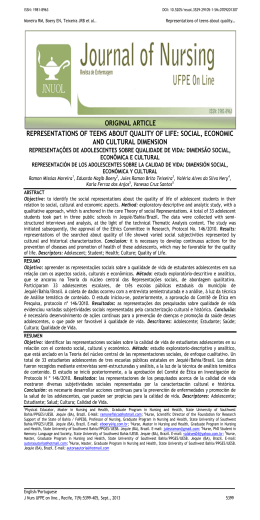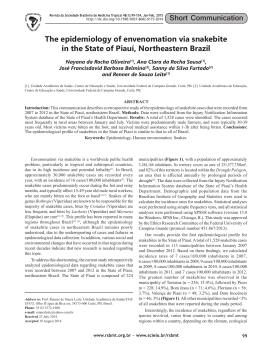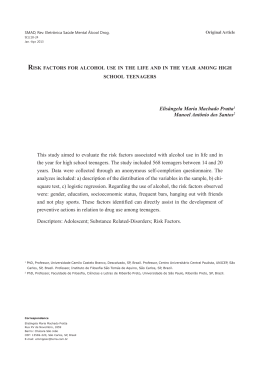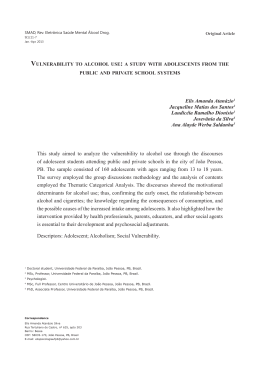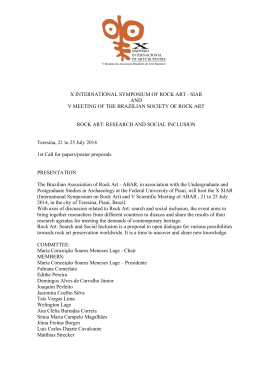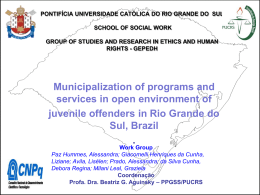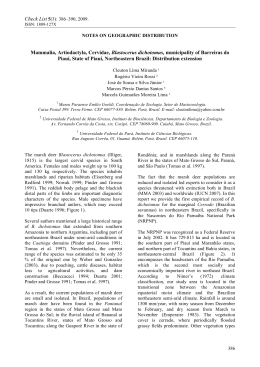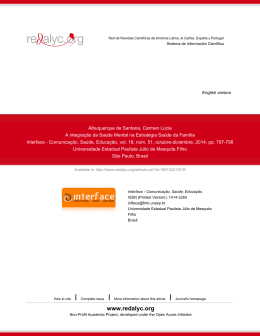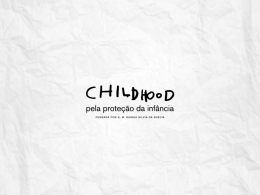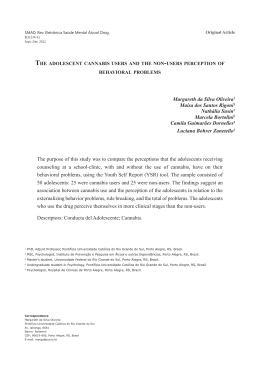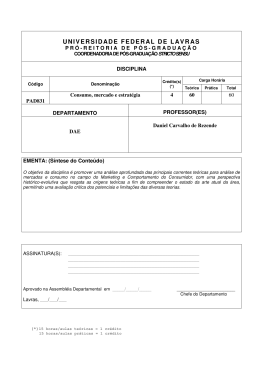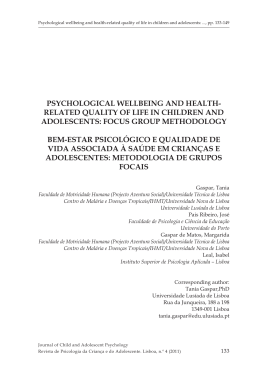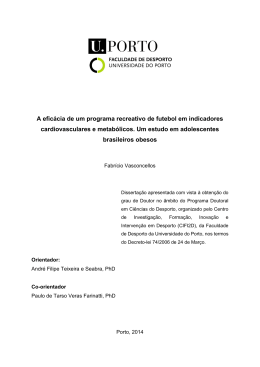Nutr Hosp. 2015;32(2):622-626 ISSN 0212-1611 • CODEN NUHOEQ S.V.R. 318 Original / Pediatría Effectiveness of an educational intervention to reduce the consumption of high-calorie foods in public school children in Teresina, Piauí (Brazil) Marize Melo dos Santos1, Vanessa Passos Oliveira1, Sueli Maria Teixeira Lima2, Kyria Jayanne Clímaco Cruz2, Ana Raquel Soares de Oliveira2, and Juliana Soares Severo1 1 Department of Nutrition, Federal University of Piauí, Teresina (Piauí). 2Postgraduate Program in Food and Nutrition, Federal University of Piauí, Teresina, Piauí (Brazil). Abstract Introduction: there is high prevalence of overweight and poor food habits among adolescents, and these factors contribute to the development of chronic diseases. Objective: the aim of this study was to evaluate the effectiveness of an educational intervention designed to reduce the consumption of high-calorie foods in public school children in Teresina, Piaui, Brazil. Materials and methods: quasi-experimental, randomized, quantitative intervention study involving adolescents (n = 126) of both sexes aged 10–14 years. An educational intervention, which involved 9 weekly meetings, was developed. A questionnaire was completed prior and subsequent to the intervention. Associations between variables were examined using a chi-square test (x2). Results and discussion: there was a significant reduction in the consumption of soft drinks and processed juices subsequent to the educational intervention (p = 0.007). It has further reduction in weekly consumption of food like meat and sausage (p = 0.072). Adolescents’ weekly consumption of fried foods and potato chips also decreased significantly subsequent to the educational intervention (p < 0.001). Conclusions: the food and nutrition educational program was efficacious in reducing the adolescents’ intake of high-calorie food and drinks and contributed to an improvement in the quality of food consumed by the schoolchildren evaluated. (Nutr Hosp. 2015;32:622-626) DOI:10.3305/nh.2015.32.2.9183 Key words: Students. Food habits. Obesity. Fast foods. Intervention studies. EFECTIVIDAD DE UNA INTERVENCIÓN EDUCATIVA SOBRE EL CONSUMO DE ALIMENTOS ALTOS EN CALORÍAS POR NIÑOS DE ESCUELAS PÚBLICAS DE TERESINA, PIAUÍ (BRASIL) Resumen Introdución: existe una alta prevalencia de sobrepeso y hábitos alimentarios pobres entre los adolescentes, y estos factores contribuyen al desarrollo de enfermedades crónicas. Objetivo: el objetivo de este estudio fue evaluar la efectividad de una intervención educativa diseñada para reducir el consumo de alimentos con alto contenido calórico en los niños de las escuelas públicas en Teresina, Piauí (Brasil). Material y métodos: estudio cuasi-experimental, aleatorizados y de intervención cuantitativo realizado con adolescentes (n = 126), con edades comprendidas entre 10 y 14 años, de ambos sexos. La intervención educativa se desarrolló durante nueve semanas, con reuniones semanales. Se realizó una encuesta previa y posterior a la intervención. Las asociaciones entre las variables fueron examinadas usando una prueba de chi-cuadrado (x2). Resultados: se observó una reducción significativa en el consumo de refrescos y jugos procesados posterior a la intervención educativa (p = 0,007). Tiene una mayor reducción en el consumo semanal de alimentos embutidos (p = 0,072). El consumo semanal de los adolescentes de alimentos fritos y patatas fritas también se redujo significativamente después de la intervención educativa (p < 0,001). Conclusiones: el programa educativo de alimentación y nutrición fue eficaz en la reducción de la ingesta de alimentos altos en calorías y bebidas de los adolescentes, lo cual contribuyó a una mejora en la calidad de los alimentos consumidos por los niños de las escuelas evaluadas. (Nutr Hosp. 2015;32:622-626) Correspondence: Marize Melo dos Santos. Federal University of Piauí. Campus Ministro Petrônio Portela. Avenida Senador Arêa Leão, 2600/202, São Cristóvão, Teresina-Piauí (Brasil). E-mail address: [email protected] DOI:10.3305/nh.2015.32.2.9183 Palabras clave: Estudiantes. Hábitos alimentarios. Obesidad. Comidas rápidas. Estudios de intervención. Recibido: 25-IV-2015. Aceptado: 27-V-2015. 622 018_9183 Efectividad de una intervencion.indd 622 10/07/15 16:00 Introduction Overweight and obesity have reached epidemic proportions worldwide, with high prevalences in all age groups1. In Brazil, the proportions of overweight children and adolescents have increased, reaching more than 30% and 20%, respectively, with a three- to fourfold increase between 1974 and 20092,3. It is important to note that this epidemiological trend may result from changes in children’s and adolescents’ lifestyles and food habits. Studies evaluating children’s and adolescents’ eating patterns in Brazil have revealed high intake of processed juices, soft drinks, and foods high in sugar and fat and decreased consumption of milk, fruit, and vegetables4-7. Poor food habits contribute to increased risk of chronic diseases such as obesity, type 2 diabetes mellitus, and cardiovascular disease. Inadequate nutrition in children and adolescents promotes the development of obesity in adulthood and severe obesity in later life. Research has also shown that excessive weight gain during childhood and adolescence is a determinant of increased risk of cardiovascular mortality in adults1,8,9. Therefore, the examination of eating habits is crucial to the development of intervention strategies with actions targeting different stages of individuals’ lives to prevent and control chronic diseases, malnutrition, and specific nutritional deficiencies10,11. Food and nutrition education is important in highlighting a set of actions to share knowledge and practices that may contribute to the improvement of the population’s living conditions, health and food security, and nutrition. Food and nutrition education includes the provision of information, encouragement to perform self-care, and articulated and continuous education strategies and is therefore considered a tool that promotes health via the development of healthy eating habits12,13. Considering the high prevalence of overweight and poor eating habits in adolescents and its role in the development of chronic diseases, this study aimed to evaluate the effectiveness of an educational intervention designed to reduce the consumption of high-calorie foods in public school children in Teresina, Piauí, Brazil. Materials and methods Population and sample A quasi-experimental, randomized, quantitative intervention study was conducted between June 2011 and June 2012 and included adolescents of both sexes who were aged 10–14 years and attended municipal public network schools in Teresina, Piauí, a city in northeastern Brazil. Effectiveness of an educational intervention to reduce the consumption of high-calorie foods in public school… 018_9183 Efectividad de una intervencion.indd 623 Sample size calculation was performed in randomized steps. In the first phase, we considered 302 schools registered with the City Department of Education and Culture in 2011 and defined the clusters formed by schools in the northern (70), southern (95), eastern (84), and southeastern (53) district areas, from which the northern district area was chosen at random. Of the 70 schools located in this area, only 28 contained adolescents aged within the required age range. In the second stage, three urban schools were chosen from the 28 schools identified in Stage 1. We also included a countryside school, resulting in the selection of four schools in which to implement the educational intervention. The final step involved the selection of a class of each grade from each school, resulting in a sample consisting of 134 students, who were assigned to intervention groups containing a maximum of 15 students. Adolescents and their parents or guardians were informed about the study at a meeting, during which they signed the consent form, “Statement of Consent – IC.” The study was approved by the Ethics in Research Committee at the Federal University of Piauí (protocol number 0076.0.045.000-11). Intervention Program The intervention program was planned in collaboration with the team involved in the educational process used to define the teaching strategy and prepare educational materials (e.g., posters, flipcharts, and folders). The planning included workshop and revenue development and the purchase of food. The educational model consisted of teaching units with the following themes: the importance of food for health, food hygiene, and the preparation of healthy foods. The intervention was based on problem-based education proposed by Paulo Freire14 which is open to knowledge and change, and involved theoretical and practical instruction, with student participation consisting of using posters, puppets, and videos; creating educational murals; and preparing fresh food. Educational sessions were conducted by undergraduate students, under the supervision of nutritionists (teachers and project coordinators), in the Department of Nutrition at the Federal University of Piauí and involved 9 weekly meetings. The educational intervention lasted 90 minutes, on average, and was delivered in rooms provided for the program. Specific content for each teaching unit was developed according to the related theme. Effectiveness of the intervention in reducing consumption of high-calorie food To evaluate the effectiveness of the educational intervention in reducing the consumption of high-calorie Nutr Hosp. 2015;32(2):622-626 623 10/07/15 16:00 food, participants completed the same questionnaire prior and subsequent to the intervention. The questionnaire consisted of four closed questions concerning weekly consumption of bologna and sausages; candy (stuffed cakes, chocolates, and ice cream); fried foods and processed snacks; and soda or processed juice (bottle or carton). Each question contained five answer options (no, once, twice, three times, or four or more times weekly) describing the frequency of consumption of food from these food groups. Statistical analysis Data were processed and analyzed using SPSS 16.0 for Windows (SPSS Inc., Chicago, IL, EUA). Descriptive analysis of the data was performed using the frequencies and percentages for each event. Associations between variables were examined via chi-square test (x²), with statistical significance set at p < 0.05. Fig. 2.—Weekly consumption of food like meat and sausage by adolescents from the municipal public school system in Teresina prior and subsequent to the educational intervention, 2013 (n= 126). Discussion The participants were 126 students from municipal public schools, of whom 53.5% were male and 46.5% were female. Eight students did not complete the intervention program, as they transferred to other schools. Information regarding the effectiveness of the educational intervention in reducing the consumption of high-calorie foods is shown in Figures 1–3. The consumption of soft drinks and processed juices more than three times a week (55.6%) decreased significantly (37.3%) subsequent to the educational intervention (p = 0.007; Fig. 1). It has a further reduction in weekly consumption of food like meat and sausage in the frequency of three and four or more times (p = 0.072; Fig. 2). Adolescents’ initial consumption of fried foods and potato chips four or more times per week decreased significantly subsequent to the educational activity (p < 0.001; Fig. 3). This study evaluated the consumption of high-calorie foods in public school children in Teresina and the effectiveness of an educational intervention designed to reduce high-calorie foods intake. The nutrition education program showed significant results with respect to the adolescents’ development of healthy eating habits. The results are congruent with those reported by Gonzalez-Jimenez et al.15 showing a reduction in the prevalence of adolescents’ overweight and obesity subsequent to health education interventions in schools. Some studies have shown that knowledge regarding the effect of food on health contributes to healthier food choices16,17. Childhood and adolescence are important periods in the development of nutrition education activities that focus on knowledge, as choices and preferences formed at this stage tend to become habits in adulthood18. In this study, although the consumption of soft drinks and processed juices was high in the participating adolescents, it decreased significantly (p = 0.007) subsequent to the educational intervention. This may be related to the low cost of these products, as the participants attended public schools that, a priori, contain students from low-income families. Fig. 1.—Weekly consumption of soft drinks and processed juices by adolescents from the municipal public school system in Teresina prior and subsequent to the educational intervention, 2013 (n= 126). Fig. 3.—Weekly consumption of fried foods and processed snacks in adolescents from the municipal public school system in Teresina prior and subsequent to the educational intervention, 2013 (n= 126). Results 624 018_9183 Efectividad de una intervencion.indd 624 Nutr Hosp. 2015;32(2):622-626 Vanessa Passos Oliveira et al. 10/07/15 16:00 According to Estima et al.19 net consumption may have different physiological effects because it does not usually activate satiety centers, leading to greater energy consumption. In addition, sugary drinks have a high glycemic index and their consumption can reduce intake of other nutritionally important beverages such as natural juices. This result highlights the contribution of excessive consumption of high-calorie sodas, with a high concentration of sugar, to the manifestation of chronic diseases such as obesity20. Furthermore, the composition of most soft drinks containing substances that stimulate the nervous system, such as caffeine, acidulants, colorants, and other elements, cause bodily changes such as sleep disorders. These changes vary greatly depending on the individual’s sensitivity and may cause allergic reactions, gastritis, or ulcers21. The rate of consumption of processed snacks decreased from 38.2% to 29.1% in the targeted groups, indicating improvement in food choices in adolescents participating in the nutrition education program. Changes in dietary patterns are difficult to implement, because eating habits are performed daily and involve different contexts and situations. In addition, knowledge regarding healthy eating, the availability of healthy food in the family environment, friends, social environment, cost, and the adolescent’s preferences influence food consumption22. Some studies, such as those conducted by Sahota et al.23 and Gabriel, Santos, and Vasconcelos24 found no changes in schoolchildren’s BMI subsequent to educational interventions. However, the authors observed an increase in the frequency of healthy eating, and positive changes in adolescents’ food choices have been found, even in short-term studies25. In adolescents who initially consumed fried foods and processed snacks four or more times per week, consumption decreased significantly (p < 0.001) subsequent to the intervention. In Brazil, according to the Consumer Expenditure Survey for 2008–2009, the rate of consumption of processed snacks was 56.5% and increased with the age of respondents26. It is important to note that fried foods and processed snacks contain high concentrations of sodium, saturated fats, and calories, which contribute to the manifestation of metabolic disorders and increase the risk of cardiovascular disease. Therefore, the results of this study may be useful in the prevention of these diseases in this population. The educational intervention was effective in improving the adolescents’ eating habits, as it reduced the consumption of items considered negative markers of diet quality such as soft drinks, sausages, and processed snacks. Therefore, it is evident that the implementation of food education programs is necessary in elementary schools, in order to increase schoolchildren’s awareness of, and responsibility for, their food consumption and health. Effectiveness of an educational intervention to reduce the consumption of high-calorie foods in public school… 018_9183 Efectividad de una intervencion.indd 625 Conclusions The food and nutrition education program was efficacious in reducing the consumption of high-calorie foods and contributed to an improvement in the quality of food intake in the participating schoolchildren. Conflicts of interest The authors declare that they have no conflict of interest. Acknowledgements We wish to thank the Municipal Secretary of Education - Piauí, the participating schools, parents, and adolescents for the opportunity to develop this study, and the Federal University of Piauí. Financial support International Life Sciences Institute, Brazil (ILSI-BRASIL). References 1. Beck CC, Lopes AS, Pitanga FJG. Indicadores antropométricos de sobrepeso e obesidade como preditores de alterações lipídicas em adolescentes. Rev Paul Pediatr 2011;29(1):46-53. 2. IBGE – Instituto Brasileiro de Geografia e Estatística. Pesquisa de Orçamentos Familiares 2008-2009: antropometria e estado nutricional de crianças, adolescentes e adultos no Brasil. Rio de Janeiro, 2010. 3. Leal VS, Lira PIC, Oliveira JS, Menezes RCE, Sequeira LAS, Neto MAA, et al. Excesso de peso em crianças e adolescentes no Estado de Pernambuco, Brasil: prevalência e determinantes. Cad Saúde Pública 2012;28(6):1175-82. 4. Carvalho PRC, Santos PGMD, Oliveira GTA, Melo TTS, Batista GR, Barreto EMF. Índice de massa corporal, hábitos alimentares e atividades de lazer em crianças e adolescentes. RBSP 2013;37(2):460-72. 5. Conceição SIO, Santos CJN, Silva AAM, Silva JS, Oliveira TC. Consumo alimentar de escolares das redes pública e privada de ensino em São Luís, Maranhão. Rev Nutr 2010;23(6):9931004. 6. Nunes HMB, Borges TS, Hoehr CF, Tornquist D, Burgos MS, Gaya AR. Diferenças entre os hábitos alimentares associados ao excesso de peso de crianças e adolescentes da zona rural e urbana do município de Santa Cruz do Sul – RS. Cinergis 2014;15(1):30-3. 7. Soder BF, Swanke NL, Borges TS, Todendi PF, Moares GG, Burgos MS. Hábitos alimentares: um estudo com adolescentes entre 10 e 15 anos de uma Escola Estadual de Ensino Fundamental, em Santa Cruz do Sul. Cinergis 2012;13(1):51-8. 8. Chehuen MR, Bezerra AIL, Bartholomeu T, Junqueira NO, Rezende JAS, Basso L, et al. Risco cardiovascular e prática de atividade física em crianças e adolescentes de Muzambinho/ MG: influência do gênero e da idade. Rev Bras Med Esporte 2011;17(4):232-6. 9. Kaufmann CC, Albernaz EP. Prevalência e fatores associados ao excesso de peso em crianças de uma coorte no Sul do Brasil. Revista Ciência & Saúde 2013;6(3):172-80. Nutr Hosp. 2015;32(2):622-626 625 10/07/15 16:00 10. Brasil. Ministério da Saúde. Secretaria de Atenção à Saúde. Departamento de Atenção Básica. Guia alimentar para a população brasileira. 2. ed. – Brasília: Ministério da Saúde, 2014. 11. Hinnigi PF, Bergamaschi DP. Itens alimentares no consumo alimentar de crianças de 7 a 10 anos. Rev Bras Epidemiol 2012;15(2):324-34. 12. Santos LAS. O fazer educação alimentar e nutricional: algumas contribuições para reflexão. Ciênc Saúde Colet 2012;17(2):453-62. 13. Santos LAS, Carvalho DMM, Reis ABC, Ramos LB, Freitas MCS. Formação de coordenadores pedagógicos em alimentação escolar: um relato de experiência. Ciên Saúde Colet 2013;18(4):993-1000. 14. Freire, P. Pedagogia da autonomia: saberes e práticas necessários à prática educativa. São Paulo: Paz e Terra, 1996, 148 p 15. González-Jiménez E, Cañadas GR, Fernández-Castillo R, Fuente GAC. Analysis of the life-style and dietary habits of a population of adolescents. Nutr Hosp 2013;28(6):1937-42. 16. Carvalho AP, Oliveira VB, Santos LC. Hábitos alimentares e práticas de educação nutricional: atenção a crianças de uma escola municipal de Belo Horizonte, Minas Gerais. Pediatria (São Paulo). 2010;32(1):20-7. 17. Triches RM, Giugliani ERJ. Obesidade, práticas alimentares e conhecimentos de nutrição em escolares. Rev Saúde Pública 2005;39:541-7. 18. Zarnowiecki D, Sinn N, Petkov J, Dollman J. Parental nutrition knowledge and attitudes as predictors of 5–6-yearold children’s healthy food knowledge. Public Health Nutr 2012;15(7):1284–90. 626 018_9183 Efectividad de una intervencion.indd 626 Nutr Hosp. 2015;32(2):622-626 19. Estima CCP, Philippi ST, Araki EL, Leal GRS, Martinez MF, Alvarenga MS. Consumo de bebidas e refrigerantes por adolescentes de uma escola pública. Rev Paul Pediatr 2011;29(1):41-5. 20. Carvalho FAC. O livro negro do açúcar. Rio de Janeiro: Auto-edição, 2006. 21. Rossi R, Vallinot M. Efeitos físicos e emocionais do refrigerante. Saúde, Terra 2010. Disponível em: http://saude.terra. com.br/interna/0,,OI228538-EI1502,00-Efeitos+fisicos+e+ emocionais+do+refrigerante.html. Acess em: 11 de maio de 2014. 22. Diez-Garcia RW, Castro IRR. A culinária como objeto de estudo e de intervenção no campo da Alimentação e Nutrição. Ciên Saúde Colet 2011;6(1):91-8. 23. Sahota P, Rudolf MC, Dixey R, Hill AJ, Barth JH, Cade J. Evaluation of implementation and effect of primary school based intervention to reduce risk factors for obesity. BMJ 2001;323:1027-9. 24. Gabriel CG, Santos MV, Vasconcelos FAG. Avaliação de um programa para promoção de hábitos alimentares saudáveis em escolares de Florianópolis, Santa Catarina, Brasil. Rev Bras Saude Mater Infant 2008;8:299-308. 25. Fernandes PS, Bernardo CO, Campos RMMB, Vasconcelos FAG. Avaliação do efeito da educação nutricional na prevalência de sobrepeso/obesidade e no consumo alimentar de escolares do ensino fundamental. J Pediatr 2009;85:315-21. 26. IBGE – Instituto Brasileiro de Geografia e Estatística. Pesquisa de Orçamentos Familiares 2008–2009: análise do consumo alimentar pessoal no Brasil. Rio de Janeiro, 2011. Vanessa Passos Oliveira et al. 10/07/15 16:00
Download
